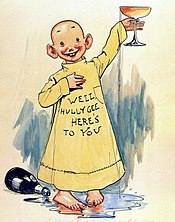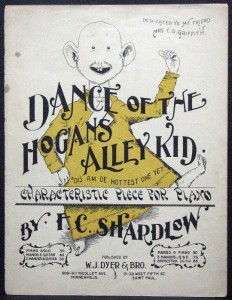This is part of a series of posts by Derek Mainhart—an entire year‘s curriculum for a comics class at the secondary level: middle school and high school. Follow us via rss, Facebook, or Twitter (buttons above to the right) to be informed when new posts go up. To search for all the posts by Derek, including all in this series, click here.
It’s Friday! You know what that means: Cartoon History! As I said earlier, I think it’s an important, oft-neglected subject. It’s also a nice way to end the week, and provides a nice rhythm to the semester. And yes, history is fun.
Objective: Exploring the history of Cartooning
Do Now: Who do you think the FIRST famous cartoon character was? When do you think it was created?
It’s always interesting to experience students’ gauge on history. A not infrequent answer is something along the lines of “Mickey Mouse in the 1960’s”.

The Information Age is a wonderful thing. There are any number of terrific resources with which to gather material. Some of my favorites are listed below under Resources. (Old-fashioned as I am, many of them are books. Giant, musty books.)
I start with The Yellow Kid simply because most Cartooning Histories use him as a convenient starting point, coming as he does near the dawn of the 20th century. This approach has merit, though it is certainly debatable (as we’ll see below). Your presentation method is up to you. As I’ve said before, I use Smartboard. Some major points you may want to address in your discussion:







Exercise: The Yellow Kid achieved fame around the turn of the twentieth century. Students will create a Yellow Kid for the early twenty-first century. Here are some examples:

Here he is, flummoxed by modernity… Here, all ‘gangsta’ as the kids say… And here, with lobster claws for some reason.
Thanks Shannon, Nic and Reily!
The Comics, Brian Walker. Abrams ComicArts
America’s Great Comic-Strip Artists, Richard Marschall. Stewart, Tabori & Chang
100 Years of Newspaper Comics, Maurice Horn. Gramercy
Masters of American Comics, John Carlin, Paul Karasikand Brian Walker. Hammer, Moca, Yale
There was also Don Markstein’s excellent Toonopedia website, but I haven’t been able to access it since Mr. Markstein sadly passed last year. If anyone has any information on this, it would be greatly appreciated.
So this week you:
Next week we’ll develop this project in earnest. ‘Til then, Happy Friday!
Derek Mainhart is an art teacher at Deer Park High School and at the Usdan Center for the Creative and Performing Arts. He has taught widely at many institutions such as Molloy College, Boricua College and Hofstra, among others. He teaches cartooning workshops in the greater New York area. In addition, he was the first Vice President of the Museum of Comic and Cartoon Art (MoCCA) in Manhattan, and was instrumental in the formation of its annual MoCCA Art Festival. He has organized and participated in numerous gallery exhibits in and around NYC. His self-published works include The Iraqi Tinies and W. He is married to web-cartoonist and fellow art teacher Ali Solomon. They live with their daughter in Forest Hills (not far from the house where Peter Parker grew up.)
Read Derek’s comic book reviews at: http://imagesandnerds.wordpress.com/
Comments